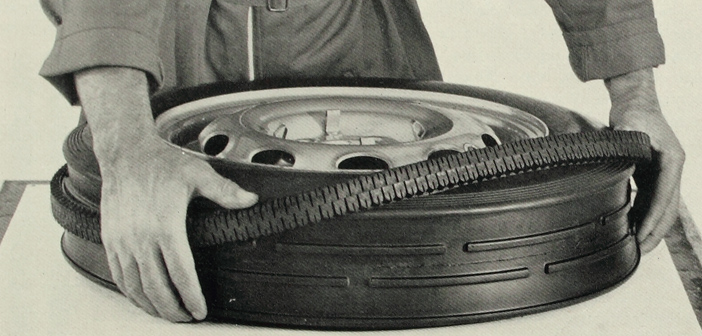It’s 60 years since Pirelli launched one of the most innovative products in its history. The BS3 – from the Italian ‘battistrada separata’, or ‘separate tread’ – appeared at the 1959 Turin Motor Show. This radical design consisted of a carcass and tread pattern that were not vulcanized together, which meant that tread patterns could be switched easily without even removing the wheel from the car.
The BS3 enabled the tire to be conveniently adapted to either winter or summer conditions, depending on the season. The concept remained in production for several years.
This was a disruptive technology at the time and remains unique to this day. The man who signed the Pirelli BS3 patent form was Carlo Barassi, who at the time was head of technology in Pirelli’s technical office (now known as R&D). But the idea was born a few years earlier from the creative mind of fellow engineer Giuseppe Lugli, the then-head of the physics laboratory in Pirelli’s tire department. Lugli loved skiing and the mountains, so was very familiar with the challenges of winter driving. Up to that point, the most common way for drivers to deal with winter conditions had been to install snow chains, although Nokian had introduced its first winter tire as early as 1934.
With the BS3, the tread was mounted on three rings of the same diameter as the actual tire carcass. These were attached to the tire carcass and held in place by very high interfacial contact pressure between body and belt plies created by inflation and the interlocking tongue-and-groove arrangement. The summer tread pattern for the BS3 was borrowed from the Cinturato. When the season changed, it was sufficient to take off the existing tread and replace it with one that was more suited to winter conditions, rather than replace the tire completely.
Pirelli notes that the arrival of the BS3 also ushered in another innovation. Thanks to an agreement with Autogrill, a network of service stations, Pirelli created dedicated workshops on the Autostrada del Sole motorway that links northern Italy to the south. There, technicians were able to swap BS3 tread patterns, as well as look after any other tire-related needs that motorists had.
The BS3’s switchable tread concept also made its presence felt in motorsport. The tire was used on the 1961 Rallye Monte-Carlo, with 23 of the 28 BS3-equipped crews finishing the rally. Rallying subsequently helped to develop Pirelli’s first dedicated winter tire, the MS35. The MS35 was driven to multiple victories by Sandro Munari in a Lancia Fulvia, including on the 1972 Monte.
As for the pioneering BS3, the major strides made in vehicle performance rendered the concept of a separate tire and tread pattern obsolete. There was also the risk that the tread could detach from the tire if proper inflation was not maintained. Pirelli instead focused its efforts on pure winter tires, and 60 years later the Italian firm has a specialized family of winter tires that includes the Scorpion Winter for SUVs, P Zero Winter for performance cars and Cinturato Winter for compact and mid-sized cars.



